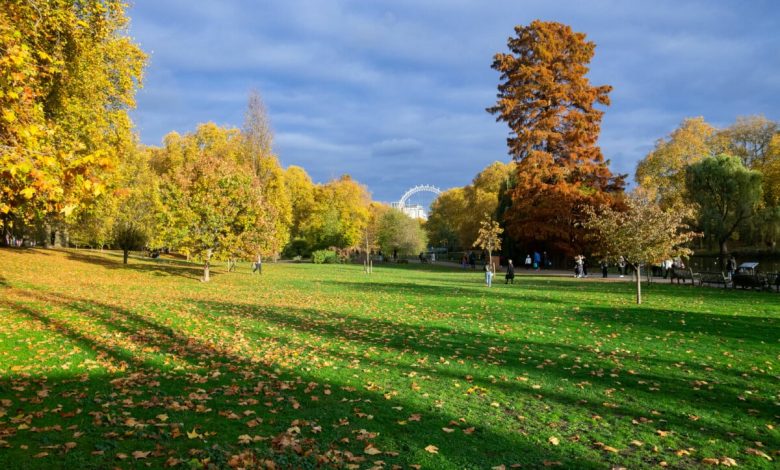St James’s Park: cultural heritage profile

Diplomat.Today
Welcome to our comprehensive travel guide to visiting St James’s Park, a destination known for its unique blend of cultural richness, history and educational value in London, United Kingdom.
Here you will find detailed insights into what makes St James’s Park such a unique cultural attraction.
About
Gallery
Details
Assessment of cultural heritage
Universal appeal and cultural authenticity
Cultural wealth and educational value
Conservation and integrity
Accessibility and visitor engagement
Overall rating: 4.7/5
Global influence
- St James’s Park is recognized worldwide as one of London’s most iconic and historic royal parks, attracting millions of visitors every year.
- It is a major draw for international tourists and contributes to London’s vibrant tourism industry.
- The park’s picturesque landscapes and historical significance have inspired countless artists, writers and filmmakers, influencing global culture and art.
- St James’s Park has been involved in international events, such as diplomatic meetings and state visits, contributing to its global fame and influence.
Historical impact
- With a history dating back to the Tudor period, St James’s Park has been the setting for many important historical events, including royal processions and public ceremonies.
- The park has an archaeological significance, with traces of historical development and architectural features dating back centuries.
- It has played a crucial role in the local and national history of the United Kingdom, serving as a royal hunting ground and later as a public park.
- Notable historical figures associated with St James’s Park include King Charles II, who commissioned its redesign in the 17th century, and renowned architect John Nash, who contributed to its transformation.
Conservation efforts
- Current conservation projects aim to preserve the park’s historic features, landscapes and biodiversity, while ensuring public accessibility.
- Organizations such as The Royal Parks and The St. James’s Conservation Trust are actively involved in the conservation and conservation of St James’s Park.
- Government initiatives, private donors, and partnerships with corporate sponsors provide funding and support for conservation efforts.
- The community is actively involved in conservation efforts through volunteer programs, educational initiatives and awareness campaigns to protect the park’s heritage.
Our reason for reviews
- Universal appeal and cultural authenticity (88/100)
- St James’s Park stands out as a quintessential representation of English landscape design and embodies the cultural essence of London’s historic gardens.
- Its central location and proximity to iconic landmarks such as Buckingham Palace and Big Ben increase its appeal to locals and tourists.
- The park has successfully retained its original character while integrating modern amenities, keeping it relevant and accessible to today’s audiences.
- Cultural richness and educational value (85/100)
- The rich history of St James’s Park, dating back to the 16th century, offers visitors deep insights into London’s royal and cultural heritage.
- Educational signage and occasional guided tours provide valuable information about the park’s historical significance and biodiversity.
- The diverse wildlife, including the iconic pelicans, adds to the educational value of the park, especially for nature lovers.
- Conservation and integrity (90/100)
- The park’s maintenance and conservation efforts are exemplary, ensuring that its historic and natural features remain well protected.
- Organizations such as The Royal Parks and The St. James’s Conservation Trust are actively involved in conservation initiatives and safeguarding the park’s future.
- Community involvement through volunteer programs and educational campaigns is crucial to the park’s conservation.
- Accessibility and visitor engagement (95/100)
- St James’s Park is very accessible, with multiple access points and close proximity to major public transport stations, making it easy for residents and visitors to explore the area.
- The park offers a range of facilities, including toilets, cafes and gift shops, which enhance the overall visitor experience.
- Interactive opportunities such as wildlife watching, picnics and walks around the picturesque lake ensure high visitor engagement and satisfaction.
Historical importance
St James’s Park, London’s oldest royal park, has a rich historical background dating back to the 16th century. The park was originally a swamp area that was created in 1531 under King Henry VIII. It was later landscaped and transformed into a royal park. Notable events associated with the park include its use as a deer park during the Tudor period and its association with King Charles II, who ordered its redesign in the 17th century.
Cultural importance
St James’s Park is important and culturally relevant in London and beyond. It is a tranquil oasis in the heart of the city, influencing local traditions, arts and community activities. The park’s picturesque landscapes have inspired countless artists and writers over the centuries, contributing to the city’s cultural tapestry.
Architectural style
The architectural style of St James’s Park is characterized by classic English landscape design. It features winding paths, serene water bodies and carefully curated plantings, embodying the essence of an idyllic urban park. The park also showcases iconic landmarks such as the Blue Bridge, which offers stunning views of Buckingham Palace and the Horse Guards Parade.
Visitor experience
Visitors to St James’s Park can expect a serene and picturesque experience. While it may not host tours or special exhibitions, the general atmosphere of the park offers a tranquil retreat from the bustling city. The park is ideal for walks, picnics and wildlife watching, with an array of waterfowl and other bird species inhabiting the park’s lake.
Accessibility and amenities
St James’s Park is accessible to a range of groups, including families and people with disabilities. The park offers amenities such as restrooms, cafes and gift shops, enhancing the overall visitor experience. Its central location in Westminster makes it easily accessible for locals and tourists.
Best times to visit
- Early mornings: The park is usually not busy from 5 a.m. to 8 a.m., making it an ideal time for visitors who prefer a quiet, serene atmosphere to jog or enjoy nature without the crowds.
- Weekday afternoons before peak hours: On weekdays, the park’s popularity starts to increase after 9 a.m. and peaks around 3 p.m. A visit between 10am and 1pm is optimal to avoid the busiest times and still enjoy the lively atmosphere of the park.
- Late evenings: From 7pm onwards the crowd size reduces significantly, offering a more relaxed experience. This time is perfect for evening walks as the park stays open until midnight. This time also offers beautiful sunset views and cooler temperatures during the warmer months.
Ratings and reviews
Reviews of St James’s Park generally praise its tranquil atmosphere, scenic beauty and central location. Visitors often praise the park for its well-maintained grounds and the opportunity to observe wildlife in the heart of the city. Common praise includes the park’s proximity to major attractions such as Buckingham Palace and the Mall. However, some visitors note that the park can be crowded during peak season.
Photographic possibilities
St James’s Park offers plenty of photogenic spots, including its picturesque lake, lush gardens and iconic views of nearby landmarks. The Blue Bridge in particular provides an excellent vantage point for capturing panoramic scenes of the park and surrounding area. Early morning or late afternoon visits are recommended to capture the beauty of the park in the best light.



